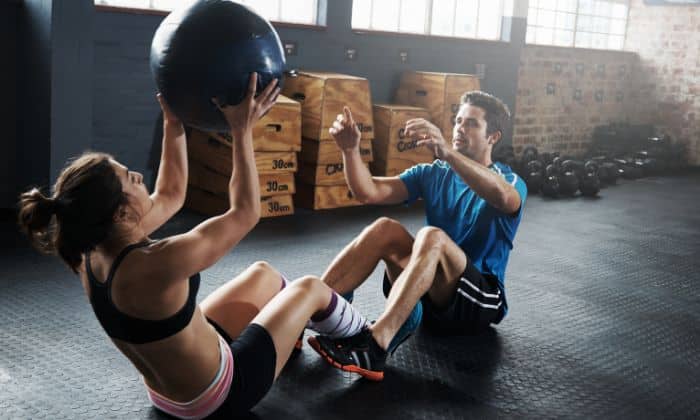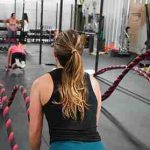Are you curious about how core conditioning can transform your fitness routine? Do you wonder how core training contributes to overall health and fitness? You may be starting and looking for core strengthening exercises for beginners, or you want to understand the connection between core and balance.
If these questions catch your interest, you’re in the right place.
Core conditioning is about more than achieving toned abs. It’s the foundation of your body’s strength and stability. This training is key for better posture, lowering injury risks, and boosting athletic performance. It’s vital for everyone, from fitness enthusiasts to beginners.
Learning the basics of core conditioning, including core training and exercises for beginners, is crucial. These workouts enhance not just physical abilities but overall health and fitness.
What is Core Conditioning?
It’s a key part of fitness that focuses on abdominal strength, lower back, hips, and pelvis. These areas are important because they support your spine and body. This makes your daily activities easier and boosts your overall physical ability.
Core conditioning is different from general fitness routines. While general fitness might target specific body parts or overall endurance, core conditioning zeroes in on your body’s center.
Whether you’re just starting or an experienced athlete. It’s not only about getting a flat stomach. It’s about building a strong foundation for your body.
This type of training is particular because it improves stability, balance, and posture. It’s a crucial part of fitness, especially for beginners.
Starting with core strengthening exercises is a smart move. It helps make your workouts safer and more effective. By focusing on core and balance, you’re setting yourself up for success in your fitness journey.

7 Benefits of Core Conditioning
Core conditioning improves your balance and stability. You gain better control over your body movements by strengthening the core muscles. This is especially beneficial in activities requiring coordination, like sports or simple tasks like walking on uneven surfaces.
Enhanced Stability and Balance
Core conditioning improves your balance and stability. You gain better control over your body movements by strengthening the core muscles. This is especially beneficial in activities requiring coordination, like sports or simple tasks like walking on uneven surfaces.
Reduced Risk of Injury
A strong core is crucial for injury prevention. It stabilizes, reducing the strain on your muscles and joints during physical activity. This means fewer injuries and less pain, especially in the back and hips.
Improved Posture
Regular core training significantly improves your posture. It strengthens the muscles that support your spine, leading to a straighter back and reduced strain on your spine and neck. Good posture also helps reduce back pain and enhance your overall appearance.
Better Athletic Performance
Athletes benefit greatly from core conditioning. A strong core enhances their power, agility, and endurance. This leads to better performance in almost all sports and physical activities.
Easier Everyday Movements
A well-conditioned core makes daily activities easier. Tasks like lifting, bending, and reaching become more effortless. This is because your core is involved in almost every movement your body makes.
Enhanced Breathing
Core strength is linked to better breathing. The diaphragm, a key muscle in breathing, is part of the core. Stronger core muscles support better lung function and more efficient breathing.
Improved Balance in Body Weight
Core conditioning helps evenly distribute body weight. This balance is important for maintaining a healthy body structure and preventing muscle imbalances that can lead to injuries.
Who Should Do Core Training?
Core training is important for everyone, no matter how fit you are or what your goals might be. A study from the National Library of Medicine shows how key core strength is for our health and how we move.
Starting with basic core exercises is a great idea if you’re new to working out. These exercises build a strong base for tougher workouts later on.
Core conditioning can be tailored to fit anyone. If you’re just starting, you can do simple exercises. As you get better, you can try harder ones. This way, everyone can safely improve their core strength.
The study also points out that a strong core doesn’t just help athletes. It’s good for reducing the chance of getting hurt and making everyday movements easier. So, core training is a must-do part of staying fit and healthy, whether you’re into sports or just want to keep active.
How Many Core Workouts Per Week?
Adding core training to your fitness routine is important. It helps you get stronger and stay healthy. But you might wonder how often you should do core workouts.
Aiming for two to three sessions a week is ideal. This schedule allows your muscles adequate time to recover and grow stronger. It ensures consistent work on your core.
It’s important to mix core workouts with other exercises. You can do cardio, strength training, or stretching on other days. This mix keeps your whole body fit and stops you from overworking any one part. Plus, it keeps your exercise routine fun and varied.
You can still fit in core training if you’re busy or have a changing schedule. You can do short, effective workouts. Even 10 to 20 minutes can make a difference. The main thing is to keep doing them regularly. Doing core workouts often, even briefly, is great for your fitness and health.
But always remember, being consistent is more important than pushing too hard. Regular, steady workouts are the key to success in core conditioning.

20-Minute Core Strengthening Exercises for Beginners
Starting core conditioning can be simple and effective, especially with a 20-minute beginner routine. This workout is perfect for those new to core training. It helps build strength without needing a lot of time.
Here’s an 8-step beginner-friendly core workout:
Step 1 – Basic Forearm Planks
Begin in a forearm plank, ensuring your body forms a straight line. Maintain this position for 30 seconds, focusing on normal breathing and a tight core to maximize effectiveness.
Step 2 – Side Planks for Oblique Strength
Transition into a side plank, supporting yourself on one arm and the edge of your foot. Hold this for 15 seconds on each side. This exercise is excellent for strengthening the oblique muscles and enhancing your overall core stability and balance.
Step 3 – Bird-Dog for Coordination
Position yourself on all fours and extend one arm forward while stretching the opposite leg backward. Hold this pose briefly before switching to the other arm and leg. This movement is great for improving coordination and stabilizing the core.
Step 4 – Bridge Pose
Lie on your back with knees bent and feet flat on the ground. Elevate your hips, forming a straight line from your knees to shoulders, and hold for 20 seconds. This exercise targets the lower back and hips, strengthening the core.
Step 5 – Leg Raises for Lower Ab
While lying on your back, gently lift your legs up and then lower them, keeping your lower back pressed to the floor. This movement focuses on the lower abdominal muscles, a crucial part of your core.
Step 6 – Seated Russian Twists
Sit with your knees bent, leaning back slightly. Rotate your torso from side to side, keeping your feet grounded if you’re a beginner. This exercise helps to tone the abdominal muscles and improve rotational strength.
Step 7 – Standing Bicycle Crunches
Stand up and perform a motion similar to bicycle crunches, bringing each elbow towards the opposite knee alternately. This low-impact exercise is a gentler version of the traditional bicycle crunch, yet effective for the core.
Step 8 – Cat-Cow Stretch
Conclude your workout with this relaxing stretch. On all fours, gently arch and round your back alternately. This stretch is beneficial in relaxing your core muscles after the workout and improving spinal flexibility.
Remember, consistency and proper form are key to effective core strengthening exercises for beginners. Make sure to create a comfortable environment for your workout. This will help you stay motivated and achieve the best results.
What Muscles Make Up the Abs?
Understanding the muscles in your abs is crucial for effective core conditioning. The abdominal region comprises several key muscles, each contributing to various movements and activities. Recognizing these muscles can enhance your workout focus and efficiency.
Rectus Abdominis
The Rectus Abdominis, often known as the ‘Six-Pack’ Muscle, creates the well-known “six-pack” appearance. It runs vertically along the front of your abdomen and is essential for bending forward and stabilizing the core. This muscle is a primary focus in many core conditioning exercises.
Obliques (Internal and External)
The Obliques, identified as the Side Abdominal Muscles, are located on the sides of your abdomen. They are crucial for twisting and side-bending movements and are significant in core and balance. Strengthening these muscles is important for overall core stability and can be achieved through targeted exercises.
Transverse Abdominis
The Transverse Abdominis is the Deepest Abdominal Muscle. It wraps around your sides and spine, acting like a corset. This muscle supports your internal organs and is key to stabilizing the core. It’s often engaged in exercises that require core compression and stabilization.
Hip Flexors
The Hip Flexors, or the Upper Thigh Muscles, are located at the top of your thighs, near the hip bones. These muscles assist in movements that bring your legs and torso closer together. Strong hip flexors are vital for maintaining core stability and are engaged in various lower abdominal exercises.
Recognizing these muscles is beneficial for core training. It allows you to target each area effectively during workouts, improving your core’s strength and balance.

Do Core Workouts Burn Fat?
Core workouts are key in your overall journey to burn fat, but they don’t just target belly fat. These exercises boost your metabolism. This helps your body burn calories and fat, not just in your belly. Knowing you can’t lose fat in just one spot is important. You combine core training, cardio exercises, and healthy eating for natural fat loss.
Do Ab Workouts Strengthen Your Core?
Ab workouts are a big part of core conditioning. They focus on the abs, a major part of your core. But the core isn’t just abs. It includes your back, sides, pelvis, and hip muscles too.
For a strong core, you need to do different kinds of exercises. This helps work all parts of your core. A good core training routine does more than make you strong. It helps with balance and overall fitness. Working your core to build strength evenly and avoid getting hurt would be best.
Why Do My Ribs Hurt After a Core Workout?
Experiencing rib pain after a core workout can be due to several reasons. It might be from overexertion or incorrect form during exercises. Sometimes, your muscles react to a new or intense workout. It’s also possible that you’re engaging your rib muscles more than necessary.
To avoid rib pain, here are five tips:
- Warm up properly before starting your core exercises.
- Focus on proper form to ensure you’re not straining your rib area.
- Gradually increase the intensity to give your body time to adapt.
- Incorporate stretching into your core workout routine to keep muscles flexible.
- Listen to your body and rest if you feel any discomfort.
Utilizing Gym Pod Equipment for Effective Core Training
At The Gym Pod, we know the importance of the right gym equipment for core conditioning. We provide tools like stability balls, medicine balls, and resistance bands. These are great for core workouts. They help you effectively work on different core muscles.
Our innovative technology at The Gym Pod enhances core training. Our equipment is designed for a full core workout. It targets all the core muscle groups efficiently. Plus, you can adjust the equipment to fit your fitness level.
In our private gym, you can have a workout just right for you. You don’t have to wait to use the equipment. And there are no distractions.
This is perfect for both beginners and those who have been working out for a while. It helps everyone have a focused and effective core conditioning session.
Wrapping Up: Impact of Core Conditioning on Your Fitness
In wrapping up, let’s remember the key points about core conditioning. It’s not just about getting a toned stomach. It’s about building a strong foundation for your body. This includes better posture, improved balance, and a lower chance of getting hurt. These benefits show why core training is so important in any fitness plan.
We encourage you to make core conditioning a regular part of your workouts. It’s great for everyone, whether you’re just starting or have been exercising for a while. Focusing on your core can boost your physical strength. It fits well with different fitness goals and ways of living.
Lastly, we invite you to try The Gym Pod for your core workouts. Our place and equipment are perfect for helping you with your core conditioning. For more tips and techniques, check out our website. Start your journey to a stronger and healthier you with The Gym Pod.
FAQs
How Do I Start Core Conditioning?
To start core conditioning, begin with basic exercises like planks, bridges, and leg lifts. Focus on form and gradually increase intensity. Incorporate these exercises into your routine two to three times a week. Learning from tutorials or joining a class for guidance is also helpful.
What Happens if I Do Core Everyday?
Doing core workouts every day can lead to muscle fatigue and strain. It’s important to give your muscles time to recover. A balanced approach is key. Mix in other types of workouts and rest days for the best results.
What Is Core Training?
Core training involves exercises that strengthen the muscles of your torso. These include your abs, back, and pelvic muscles. It’s not just about abs. Core training improves posture, balance, and overall fitness.
What Is Core Imbalance?
Core imbalance occurs when some core muscles are stronger than others. This can lead to poor posture, back pain, and increased injury risk. Balanced core workouts can prevent and correct these imbalances.
What Uses Core Strength?
Core strength is used in almost every physical activity. This includes daily tasks like lifting and bending. It’s also crucial in sports and exercises for stability and power. A strong core supports overall physical performance.






